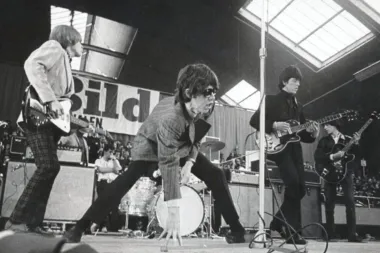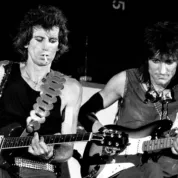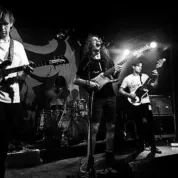
The 1960s were a transformative era, with beards, long hair, short skirts, and a lot of loud rock 'n' roll replacing the conservative trends of previous decades. Rock 'n' roll may have started in the 1950s, but it was the 1960s that transformed it into the sound and attitude we associate with the genre today. This decade produced groundbreaking creativity and cultural revolution, birthing diverse rock subgenres such as psychedelic rock, folk rock, and blues rock, which would lay the foundation of rock music for decades to come.
The 25 best 60s rock bands weren't just about sound; they were a reflection of the social and political changes sweeping across the globe. Civil Rights and racial equality were being protested, while violent political extremism stretched the fabric of Western society. Artists used their music to challenge norms, inspire change, and express the ideals of freedom and rebellion. With heavy beats, loud guitars, and challenging messages, the best 60s rock bands paved the way for future generations, influencing the sounds of the 70s, 80s, and 90s, which can still be heard in modern music today. The legacy of the 25 best 60s rock bands lives on, not only in the timeless tracks they produced but also in the enduring spirit of innovation and rebellion they championed.
1960s Folk Rock
Folk rock emerged in the 1960s by blending traditional folk music with the amplified sounds of rock 'n' roll. Characterized by jangly guitars and harmonized vocals, it deviated from the pure acoustic roots of folk by adding electric instruments and rock rhythms. This genre often featured socially conscious lyrics, reflecting the political and cultural upheavals of the era, such as the Civil Rights Movement and anti-war protests. Folk rock brought a new level of lyrical depth and activism to rock music, influencing bands to address contemporary issues through their songs.
Love
Led by frontman Arthur Lee, the American rock band Love was formed in Los Angeles in 1965. Lee also served as the band's primary songwriter, creating music that spanned from Psychedelic rock, folk rock, acid rock, and even psychedelic pop. Their sound incorporated an eclectic range of styles at a time when most rock bands were looking for new ways to put their own spin on their sound. Love was also one of the first racially diverse American rock bands, at a time when Civil Rights and racial equality were controversial and being protested.
Buffalo Springfield
Buffalo Springfield, known for featuring Neil Young and Stephen Stills before they formed Crosby, Stills, Nash, and Young, played a pivotal role in rock in the 60s. Their blend of folk rock and psychedelic music helped define the late 60s. With standout vocal performances by Young and Stills, the band's harmonies were exceptional. Their music was diverse and catchy, featuring cool guitar riffs and solos. Buffalo Springfield showcased Neil Young's songwriting talent from the start, with the rest of the band grooving along seamlessly. Among the best 60s rock bands, their contribution to the genre and influence on 60s rock artists remain significant.
The Byrds
Renowned as a psychedelic folk band, The Byrds excelled in crafting laid-back folk rock similar to the Beatles' style on "Rubber Soul." Their influence on the Beatles, especially George Harrison's songs, is notable. Featuring David Crosby, who later joined Crosby, Stills & Nash, The Byrds produced memorable guitar riffs and catchy harmonies. Their songwriting and harmony structure often drew comparisons to the Beatles, highlighting their significant impact on rock in the 60s. As one of the best 60s rock bands, The Byrds helped shape the musical landscape of the era, blending folk and rock in a way that resonated with 60s rock artists and fans alike.
Simon & Garfunkel
Simon & Garfunkel, though just a duo, crafted some of the most beautiful and well-written folk rock of the 60s. Their exceptional voices and harmonies set them apart among 60s rock bands. Known for their intricate vocal interplay, they created timeless songs that still resonate today. Their music, rich with lyrical depth and melodic beauty, epitomized the best of rock in the 60s. As one of the standout rock bands of the 60s, Simon & Garfunkel's contribution to the genre remains unparalleled, showcasing the power of simplicity and harmony in folk rock among 60s rock artists.
Bob Dylan
Bob Dylan is one of the most influential 60s rock artists, known for his unique voice and profound lyrics. Despite mixed reactions to his experimental style, Dylan's impact on rock in the 60s is undeniable. In the early to mid-60s, Dylan captured the changing American society, addressing issues like racism, government oppression, and elitism. His music resonated with the youth movement, embodying the spirit of peace and social change. Inspired by folk legends like Woody Guthrie, Dylan's early work featured thoughtful, powerful lyrics. As he transitioned to electric sound, he produced some of the best 60s rock albums, blending blues and folk with his distinctive voice and poetic storytelling. Dylan's originality and message made him a standout among 60s rock bands.
1960s Experimental Rock
Experimental rock in the 1960s pushed the boundaries of traditional rock by incorporating avant-garde techniques, unconventional song structures, and electronic sounds. This genre often featured complex compositions and abstract lyrics, creating a unique and often challenging listening experience. Influenced by the counterculture movement and a desire to break free from musical norms, experimental rock expanded the sonic palette of rock music, paving the way for future genres like progressive rock and alternative music.
The Velvet Underground
The Velvet Underground proved that commercial success doesn't always equate to influence. Despite releasing three groundbreaking LPs in the 60s, they barely touched the Billboard charts. Their highest peak was 167 with their 1967 debut, "The Velvet Underground & Nico." This album juxtaposed serene beauty with harsh dissonance, featuring Lou Reed's snarling vocals and seedy lyrics, Nico's haunting melodies, and John Cale's artful viola and piano. The band evolved with each release, shedding members along the way. 1968's "White Light/White Heat" was noisier and more abrasive, while their 1969 self-titled album, minus Cale, became softer and more accessible. As one of the best 60s rock bands, they left an enduring mark on rock in the 60s and influenced countless 60s rock artists.
The United States of America
The United States of America created one of the best psychedelic rock albums of the 60s before disbanding, a common fate for many psych bands of the era. Their music featured repetitive riffs, bizarre sound effects, and distorted guitars, capturing the essence of rock in the 60s. Dorothy Moskowitz's vocals, reminiscent of Grace Slick from Jefferson Airplane, added a unique touch to their sound. Although they didn't achieve commercial success, their innovative approach to psych rock left a lasting impact. As one of the standout rock bands of the 60s, they crafted unforgettable music that showcased the creativity and experimentation of 60s rock artists.
Grateful Dead
While the Grateful Dead's 60s studio albums were a good blend of west coast psych rock and roots music, their live performances truly defined them as one of the best 60s rock bands. Their live material from this era, especially sets like Fillmore West '69, showcased their incredible command over their songs and seamless improvisations. Known for their jamming and extended solos, the Dead's live shows were a cornerstone of rock in the 60s. Their ability to transform well-known songs with fresh, spontaneous elements made them stand out among 60s rock artists. In many ways, 60s Dead rivaled their later work, capturing the spirit and innovation of rock bands of the 60s.
1960s Southern Rock
Southern rock, rooted in the traditions of blues, country, and rock 'n' roll, emerged in the late 1960s with a distinctively gritty and soulful sound. Featuring slide guitars, strong rhythms, and passionate vocals, it deviated from mainstream rock by incorporating Southern cultural elements and storytelling. This genre celebrated Southern pride and resilience, often reflecting the social and political tensions of the Civil Rights era. Southern rock brought a raw, heartfelt energy to rock music, influencing the development of other rock subgenres in the following decades.
The Allman Brothers Band
Labeling the Allman Brothers Band as simply "Southern rock" doesn't capture their full scope. Based in Macon, Georgia, their music transcended regional stereotypes. Gregg Allman's soulful voice, paired with Duane Allman and Dickey Betts' twin guitar harmonies, delivered a rich, expansive sound. Their 60s self-titled LP featured the psychedelic "Dreams," a confident blues-rock cover of Muddy Waters' "Trouble No More," and the jazz-tinged "Whipping Post," showcasing the symbiotic drumming of Jaimoe and Butch Trucks. As one of the best 60s rock bands, their innovative blend of genres left a significant mark on rock in the 60s and influenced countless 60s rock artists.
Creedence Clearwater Revival
What is there not to love about Creedence Clearwater Revival (CCR)? They had catchy guitar riffs, energetic and emotional vocals from John Fogerty, and recognizable bass lines that added to their unique sound. As one of the best 60s rock bands, CCR helped pave the way for southern rock, blending swamp rock with rock in the 60s. Their ability to jam resulted in interesting solos and rhythms that set them apart from other rock bands of the 60s. CCR's music was incredibly catchy, with John's powerful vocals standing out among 60s rock artists. Their contribution to the rock scene in the 60s remains influential and enduring.
1960s Pop Rock
Pop rock in the 1960s combined the catchy melodies and accessible lyrics of pop music with the energetic instrumentation of rock. Characterized by its polished production and radio-friendly appeal, this genre deviated from the edgier sounds of traditional rock by focusing on harmony and simplicity. Influenced by the cultural shifts towards more liberal and youthful expressions, pop rock became a dominant force on the charts, shaping the sound of mainstream music and making rock music more palatable to a wider audience.
The Monkees
The Monkees, comprising Americans Micky Dolenz, Peter Tork, Michael Nesmith, and Brit Davy Jones, evolved from a Beatles-inspired act into a unique 60s rock band. Initially, session players performed most of their tracks, but hits like "I'm a Believer" and "Last Train to Clarksville" showcased their infectious sound. As they gained more control over their music, the group ventured into more experimental territory. Their 1968 film soundtrack, "Head," is an underrated gem of psychedelic rock. Despite their origins, the Monkees became one of the best 60s rock bands, leaving a lasting impact on rock in the 60s and among 60s rock artists.
The Kinks
Often hailed as early pioneers of punk rock, the Kinks revolutionized the use of the power chord in guitar riffs, influencing countless rock bands. Though not the first to use power chords, their innovative style popularized this technique, which became a staple in punk, metal, and hard rock genres. As the 60s progressed, the Kinks transitioned from generic rock to crafting some of the best pop music of the era, incorporating catchy riffs, horn segments, and sarcastic, humorous lyrics. Their unique blend of cynical lyrics with happy melodies set them apart from other British Invasion bands, solidifying their legacy in rock history.
The Beach Boys
Emerging in 1962, The Beach Boys quickly became one of the best 60s rock bands. Their early surf rock sound, featuring catchy instrumentals and vocal harmonies, resonated with the youth culture of California. As rock in the 60s evolved, The Beach Boys stood out among rock bands of the 60s, rivaling even the British Invasion. By 1965, Brian Wilson shifted their music from surf rock to a more mature, pop-oriented sound. This change produced the critically acclaimed "Pet Sounds," showcasing their innovative approach. Despite internal conflicts, they continued to influence 60s rock artists with their unique blend of psychedelic and rock music.
The Who
Equally revolutionary, The Who were among the best 60s rock bands, part of the mod rock movement. This movement, made up of young, rebellious hipsters in England, found the perfect soundtrack in The Who’s energetic and proto-punk music. Their 60s rock in the 60s reflected their youthful spirit, with Keith Moon’s energetic drumming, Pete Townshend’s powerful guitar riffs and solos, and Roger Daltrey’s passionate vocals. They crafted great mod rock and psychedelic music, with “Tommy” being one of the best rock operas, showcasing their talent. Despite being young, The Who’s innovative sound and rebellious attitude solidified their place among iconic 60s rock artists.
The Beatles
The Beatles are undoubtedly among the best 60s rock bands, revolutionizing rock in the 60s. Emerging in 1962 with Paul, Ringo, George, and John, they started with upbeat rock inspired by Elvis and Chuck Berry. However, their evolution was remarkable. By the time they released "Rubber Soul," the Beatles had transformed into pioneers of diverse genres like blues, folk, psychedelic, soul, and pop. Albums like "Revolver," "Sgt. Pepper's," and "The White Album" showcase their innovative spirit and perfectionist approach. Their influence on 60s rock artists and the entire music industry remains unparalleled. The Beatles' enduring appeal and groundbreaking contributions solidify their status as one of the best 60s rock bands.
1960s Blues Rock
Blues rock fused the raw emotion of blues with the amplified energy of rock 'n' roll, creating a powerful and soulful genre in the 1960s. Featuring gritty guitar riffs, heartfelt vocals, and a strong rhythmic foundation, it deviated from the smoother sounds of traditional rock by emphasizing improvisation and expressive performances. This genre drew heavily from African American musical traditions, reflecting the era's cultural exchanges and civil rights struggles. Blues rock brought a deeper emotional intensity to rock music, influencing countless artists and bands.
Yardbirds
Known for featuring legendary guitarists like Jimmy Page, Eric Clapton, and Jeff Beck, the Yardbirds were a significant force in rock in the 60s. Constantly evolving, they transitioned from Clapton to Beck and finally to Page before disbanding, paving the way for Led Zeppelin. Their blend of blues rock was comparable to John Mayall and the Bluesbreakers, and their influence on rock bands of the 60s, including the Jimi Hendrix Experience and Led Zeppelin, was immense. The Yardbirds stood out with their catchy, original singles and impressive guitar work, making them one of the best 60s rock bands and a major influence on 60s rock artists.
The Animals
Blending English musicians with Southern blues influences, The Animals emerged as one of the best 60s rock bands specializing in blues rock. Unlike the Rolling Stones, they leaned more towards rhythmic blues, infused with rock n roll elements. What set them apart from other British Invasion bands was their distinctive style, defined by lead singer Eric Burdon and organ player Alan Price. Burdon's unique voice, with its mature tone and noticeable accent, perfectly suited their music. Price's notable organ riffs transformed the organ into a lead instrument, giving their songs a distinctive sound. Their impact on rock in the 60s remains significant among 60s rock artists.
Frank Zappa and the Mothers of Invention
Frank Zappa and the Mothers of Invention were one of the most eclectic and innovative 60s rock bands. Known for their avant-rock compositions, Zappa's music spanned jazz, psychedelic, and heavy rock, often with a humorous twist. The early Mothers of Invention lineups in the mid- to late '60s were the closest Zappa came to a stable band, featuring bassist Roy Estrada and drummer Jimmy Carl Black on all five of their albums from that era. Their groundbreaking works include the experimental "Freak Out!," the avant-garde "Absolutely Free," the psychedelic parody "We're Only in it for the Money," the doo-wop homage "Cruising with Ruben & the Jets," and the eclectic "Uncle Meat." As pioneers of rock in the 60s, Frank Zappa and the Mothers of Invention left an indelible mark on 60s rock artists and the music landscape of the time.
The Rolling Stones
The Rolling Stones are one of the best 60s rock bands, closely blending blues with rock. In the early 60s, music was shifting from family-friendly pop to more edgy rock n roll, and the British Invasion was part of this evolution. While the Beatles were popular among teenage girls, bands like the Rolling Stones attracted a different crowd with their bluesy, raw sound. Their early records featured bluesy guitar solos, harmonica, and rhythms reminiscent of 50s blues and R&B. Despite their wild rock star personas, the Rolling Stones consistently released incredible singles and albums throughout the 60s. They evolved their sound while staying true to their blues roots, making them one of the most innovative 60s rock bands. Mick Jagger's unique vocals, Brian Jones' musical diversity, and Keith Richards' guitar skills contributed to their distinctive style, covering genres from blues to psychedelic. Their ability to adapt and innovate made them worthy rivals to the Beatles and cemented their legacy in rock history.
Jimi Hendrix
Jimi Hendrix is widely recognized as one of the best 60s rock artists, revolutionizing rock in the 60s with his groundbreaking guitar skills. Often cited as the greatest guitarist of all time, Hendrix influenced countless musicians and bands, including Deep Purple, Led Zeppelin, and Black Sabbath. His innovative guitar solos and psychedelic jams set new standards for rock music, paving the way for hard rock and metal. Hendrix's iconic Woodstock performance remains a landmark in American music history. Despite his untimely death in 1970, Hendrix's legacy endures, with his music continuing to inspire and shape the rock bands of the 60s and beyond.
1960s Psychedelic Rock
Psychedelic rock emerged in the 1960s as a genre that sought to replicate and enhance the mind-altering experiences of psychedelic drugs. Characterized by extended instrumental solos, experimental sounds, and surreal lyrics, it deviated from traditional rock's straightforward structure by embracing a more fluid and expansive approach. Influenced by the counterculture movement, this genre became synonymous with the era's spirit of rebellion and exploration. Psychedelic rock profoundly changed rock music by encouraging greater creativity and breaking down conventional musical boundaries.
Cream
Known for their heavy blues and psychedelic rock, Cream was one of the best 60s rock bands. Often remembered as the band Eric Clapton was in during the 60s, Cream's innovations significantly influenced the development of hard rock and metal. Following in the footsteps of the Yardbirds and Hendrix, they crafted catchy blues jams with impressive guitar riffs and solos by Clapton, and Ginger Baker's incredible drumming. Despite not being everyone's favorite Clapton band, Cream's contribution to rock in the 60s remains undeniable. Their blend of blues and rock set them apart among 60s rock artists, cementing their legacy in the history of rock bands of the 60s.
The Zombies
Often overshadowed by bands like the Beatles, the Kinks, and the Rolling Stones, The Zombies are one of the most underrated rock bands of the 60s. While they had only three major hits in America—"Time of the Season," "Tell Her No," and "She's Not There"—their albums were crafted with exceptional skill. Fronted by keyboardist and songwriter Rod Argent, The Zombies' music featured a blend of jazz rock and fast-paced rock n roll, with a prominent organ and bluesy guitar. Argent's jazzy vocals were among the greatest of the 60s, defining the band's sound. Despite producing only a few albums, their 1968 masterpiece, "Odessey and Oracle," remains a highlight of psychedelic pop, often rivaling the Beatles' work. The Zombies' diverse and innovative music made them one of the best 60s rock bands, leaving a lasting impact on rock in the 60s and 60s rock artists despite their short-lived career.
Jefferson Airplane
Known for their psychedelic music and iconic appearance at Woodstock, Jefferson Airplane were one of the best 60s rock bands. Their singles were fantastic, featuring cool riffs and a strong psychedelic atmosphere. Grace Slick, the standout member, had an impressive voice that perfectly suited their style, showcasing incredible range. Jefferson Airplane encapsulated the late 60s West Coast vibe, alongside bands like the Grateful Dead. Their music helped define an entire culture, making them a key player in rock in the 60s. Among 60s rock artists, they hold a special place for their contribution to the psychedelic sound and cultural impact.
Pink Floyd
Considered one of the most original and influential 60s rock bands, Pink Floyd had a significant impact on rock in the 60s. Before their iconic 70s albums, "Dark Side of the Moon" and "Wish You Were Here," they created groundbreaking music with a distinct psychedelic sound. "Piper at the Gates of Dawn," featuring Syd Barrett on vocals and guitar, remains a top album from that era. Barrett's eccentric personality and innovative guitar riffs defined their early work, making Pink Floyd stand out among 60s rock artists. Formed by schoolmates at London University, they embraced the emerging psychedelic culture, leaving a lasting legacy in 60s rock bands history.
The Doors
Known as the quintessential psychedelic rock band of the 60s, The Doors crafted a unique sound. Jim Morrison drew from jazz and rock n roll influences, while Ray Manzarek's blues-influenced organ and electric piano bass lines defined their signature style. Robbie Krieger's flamenco and blues guitar riffs, combined with John Densmore's Latin and jazz drumming, created their late 60s blues rock and psychedelic vibe. Their debut album showcased brilliant improvisation in tracks like "The End" and "Light My Fire." Representing youth culture, Morrison's rebellious persona and poetic lyrics resonated with the hippie movement, cementing their legacy in rock history.
The Lasting Legacy of 60s Rock
The impact of the 25 best 60s rock bands laid the groundwork for the evolution of rock music through the 70s, 80s, and 90s, with roots that are still heard in modern music today. The experimental sounds, revolutionary lyrics, and bold cultural statements of the 1960's musicians, took the foundation of rock n' roll created a decade earlier, and gave it the rebellious sound and attitude that we know today. It's heard in the power chords of 80s rock anthems, the introspective lyrics of the 70s, and the carefree attitude of 90s grunge, while still emerging throughout many genre-blending innovations of today. By pushing the boundaries of what rock could be, the 25 best 60s rock bands defined a generation and set the stage for the continuous evolution of modern music. Their music lives on, as a constant reminder to always stay creative and committed to authenticity.







Leave a Reply!